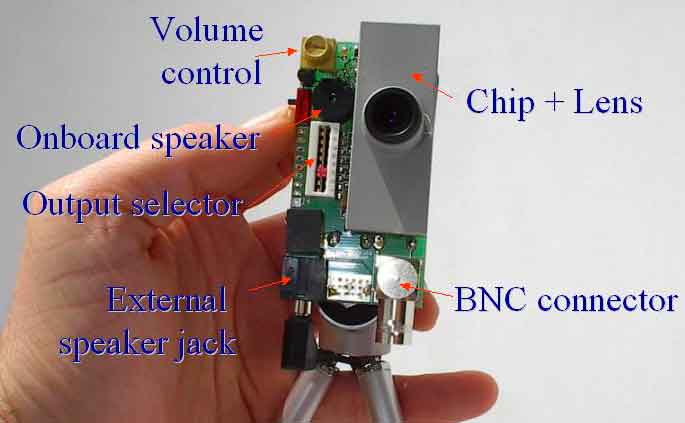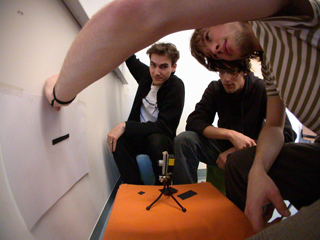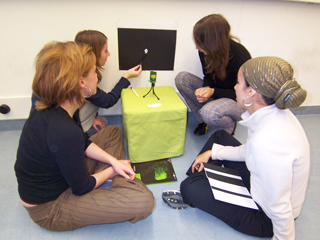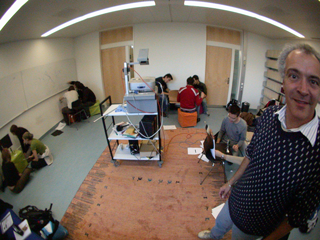![]() Note: the Physiologist’s Friend is sold out and has been discontinued. Contact us if you have any special requests concerning this product.
Note: the Physiologist’s Friend is sold out and has been discontinued. Contact us if you have any special requests concerning this product.
The Phyiologist’s Friend Chip electronically emulates cells in the visual system and responds realistically to visual stimuli. The complete design has been published.
If you are a physiologist working on the properties of the early visual system, you could use this chip as a simple substitute animal. You could use it to train students to run your rig. Or you could use it as a set of realistic and known receptive fields with spiking or analog responses for developing new spike-triggered averaging techniques. Or when debugging a new setup, you can use it simply to make sure everything runs as expected. The idea is that experimenters can test nearly the complete loop — which generally involves stimulus generation, recording, and analysis, without using actual animals. Bugs in the large portions of the setup can be found before any animals are used..
If you teach about how the brain works, the chip is a captivating way to involve the students in demonstrations of a number of basic properties of the visual system: adaptation, complementary (ON/OFF) coding, spikes, complementary push-pull input to cortical cells. Using an overhead projector, you can conduct experiments on this model visual system.
The chip outputs an ON and OFF retinal ganglion cell and two orientation-tuned cortical simple cells. Analog membrane potentials are also output and can be used to check spike discrimininators.
There are no adjustments on the chip; it is completely parameter-free. That means it is just like an opamp or ADC; you turn it on and it works. The dozen internal bias currents, which span 6 decades, are generated on-chip by a bias generator. Every chip acts the same; there is no calibration necessary.
A software simulation that models more types of cells is the Physio Friend program.

The Physiologist’s Friend Chip
Downloads
- User guide: [PDF]
- Presentation slides: [PDF] [PPT]
- T. Delbruck, S.C. Liu. (2004). A silicon visual system as a model animal. Vision Research, vol. 44, issue 17, pp. 2083-2089 (preprint; copyright restrictions prevent putting journal version here.): [PDF]
- Physiologist’s Friend Chip design: [Link]
Users
The Physiologist’s Friend Chip is used by more than 15 labs around the world.
| David van Essen | Washington Univ. |
| Gilles Laurant | Caltech |
| Kevan Martin | Inst. of Neuroinformatics, Univ. Zurich & ETH Zurich |
| Daniel Kiper | Inst. of Neuroinformatics, Univ. Zurich & ETH Zurich |
| Matteo Carrandini | Smith Kettelwell |
| Rich van Wezel | Univ Utrecht |
| Florentin Worgotter | Univ. Stirling |
| Matthias Henning | Univ. Stirling |
| Natalie Hempel de Ibarra | Freie Universitaet, Berlin |
| Rudolf Menzel | Freie Universitaet, Berlin |
| Lyle Borg-Graham | Neurophysique et Physiologie du Systeme Moteur CNRS |
| Ulf Eysel | Ruhr Univ. Bochum |
| Pam Reinigal | UC San Diego |
| Wyeth Bair | Univ. of Oxford |
| Bernd Porr | Univ. of Glasgow |
| Henry Markram | EPFL, Lausanne, Switzerland |
| Lauriston Kellaway | University of Cape Town |
| Sebastian Seung | MIT |
| Prakash Kara | Univ. of S. Carolina |
| Petra Skiebe-Corrette | Freie Universitaet, Berlin |
| Sorinel Oprisan | College of Charleston, South Carolina |



Students learn to plot receptive fields of retinal and simple cells.
Links
Matthias Hennig and Bernd Porr at the University of Stirling have used the chip for demonstrations and instruction. They have developed a linux-based USB data acquisition device.